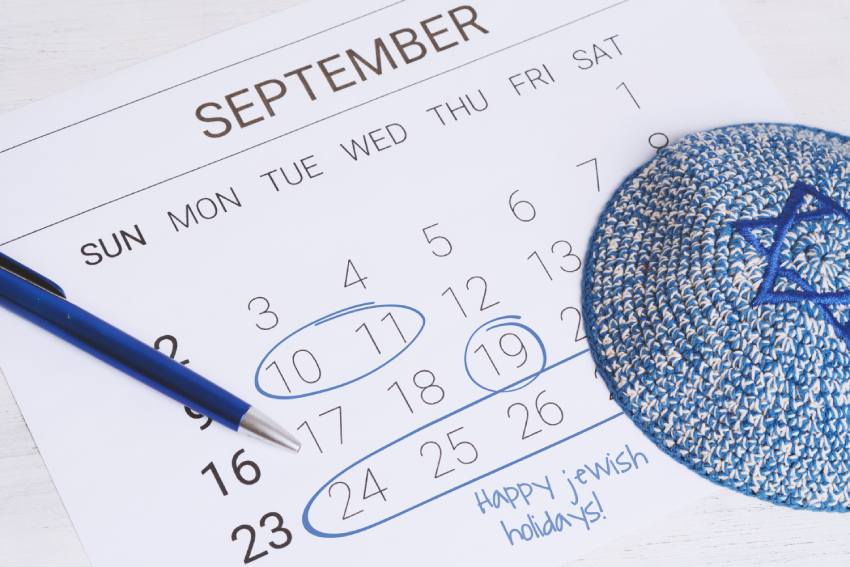Jewish Calendar: Key Dates, Holidays & How It's Determined

The Jewish calendar might seem like an ancient relic in our digital age, but here's the thing: it's actually a sophisticated system that's been tracking time, seasons, and religious observances for over 3,000 years. While your iPhone calendar tells you it's Tuesday, the Jewish calendar is simultaneously tracking lunar months, solar years, and the complex dance between them that determines when holidays fall.
Jewish Holidays by Date: When Do They Fall?
Understanding Jewish holidays by date requires accepting that they don't fall on the same secular dates each year—and that's entirely by design. The Jewish calendar is lunisolar, meaning it follows lunar months but adjusts to stay aligned with the solar year. This creates the seemingly random movement of holidays that can frustrate anyone trying to plan ahead.
Rosh Hashanah, the Jewish New Year, typically falls in September or early October. Yom Kippur follows ten days later, and Sukkot begins five days after that. These High Holy Days cluster together in the fall, creating an intense period of spiritual focus that can span nearly a month.
Passover usually occurs in March or April, coinciding with spring and the barley harvest in ancient Israel. Shavuot comes seven weeks later, traditionally marking the wheat harvest. These agricultural connections aren't coincidental—they reflect the calendar's origins in an agricultural society where religious and farming cycles were intimately connected.
Hanukkah presents an interesting case because it's determined by the Jewish calendar but often falls close to the Christian holiday Christmas on the secular calendar. It can fall anywhere from late November to late December, sometimes overlapping with Christmas and sometimes not. This variability frustrates retailers but reflects the calendar's independence from secular time-keeping.
The pattern becomes clearer when you understand that Jewish holidays are anchored to specific dates on the Jewish calendar, not the Gregorian one. Passover always begins on the 15th of Nisan, Rosh Hashanah on the 1st of Tishrei, and Sukkot on the 15th of Tishrei. The secular dates shift, but the Jewish dates remain constant.
Jewish Holidays by Importance: A Hierarchy of Celebrations
Ranking Jewish holidays by importance isn't as straightforward as you might expect, because different types of observance create different categories of significance. The Torah establishes three pilgrimage festivals—Passover, Shavuot, and Sukkot—as the most important celebrations, when ancient Jews would travel to Jerusalem.
The High Holy Days of Rosh Hashanah and Yom Kippur carry enormous spiritual weight despite being relative newcomers compared to the pilgrimage festivals. Yom Kippur, in particular, is considered the holiest day of the Jewish year, with observance requirements that surpass even Shabbat in their stringency.
Shabbat, occurring weekly, might be the most important observance of all, though it's not technically a holiday. Its weekly rhythm shapes Jewish life more than any annual celebration, and its observance requirements serve as the template for other holy days.
Hanukkah and Purim, despite their popularity, are considered minor holidays from a religious perspective. They're not mentioned in the Torah and don't carry the work restrictions of major holidays. However, their cultural significance, especially in communities where Jews are minorities, often exceeds their religious importance.
Modern additions like Yom HaShoah (Holocaust Remembrance Day) and Yom Ha'atzmaut (Israeli Independence Day) reflect the calendar's continued evolution. These observances don't have the same religious authority as ancient holidays, but they carry profound meaning for contemporary Jewish communities.
How is the Jewish Calendar Determined?
The question of how the Jewish calendar determined opens up a fascinating blend of astronomy, mathematics, and religious law. The current system, established in the 4th century CE by Hillel II, uses complex calculations to predict lunar months and coordinate them with the solar year.
Each Jewish month begins with the new moon, making months either 29 or 30 days long. Twelve lunar months total only 354 days, about 11 days short of a solar year. To prevent holidays from drifting through the seasons, the calendar adds a leap month (Adar II) seven times in every 19-year cycle.
This 19-year pattern, known as the Metonic cycle, keeps lunar months aligned with solar seasons with remarkable accuracy. The system is so precise that it accumulates only about one day of error every 216 years—impressive for calculations made without modern computers.
The calendar also includes built-in adjustments to prevent certain holidays from falling on inconvenient days. Rosh Hashanah can't fall on Sunday, Wednesday, or Friday, which would create problems with Yom Kippur and Shabbat observance. These adjustments, called dehiyyot, can shift the start of the year by a day or two.
Leap year determination follows a fixed pattern rather than astronomical observation. Years 3, 6, 8, 11, 14, 17, and 19 of each 19-year cycle are leap years. This predictability allows for long-term planning while maintaining the calendar's lunar character.
How Does the Jewish Calendar Compare to the Gregorian Calendar?
Comparing how the Jewish calendar compares to the Gregorian calendar reveals fundamental differences in philosophy and purpose. The Gregorian calendar prioritizes solar accuracy and administrative convenience, while the Jewish calendar balances lunar observation with seasonal alignment and religious requirements.
The Gregorian calendar's strength lies in its simplicity and global adoption. Every month has a predictable length, years follow a consistent pattern, and dates remain stable across centuries. This makes it ideal for business, international communication, and long-term planning.
The Jewish calendar's complexity serves different purposes. Its lunar basis connects observance to natural cycles that humans have followed for millennia. The variable dates of holidays create anticipation and require active engagement with the calendar rather than passive acceptance.
Practical differences affect daily life in Jewish communities. Hebrew dates appear on invitations, yahrzeits (death anniversaries) are observed according to Jewish dates, and religious obligations follow lunar timing. This creates a dual calendar consciousness where both systems operate simultaneously.
The Jewish calendar's agricultural origins remain relevant even in urban settings. Passover's spring timing connects to themes of renewal and liberation, while Sukkot's fall harvest celebration emphasizes gratitude and temporary dwelling. These seasonal connections provide meaning that purely administrative calendars lack.
Both systems reflect their creators' priorities and worldviews. The Gregorian calendar embodies efficiency and universality, while the Jewish calendar preserves tradition and spiritual rhythm. Understanding both helps navigate our interconnected but culturally diverse world.
Planning your Jewish holiday celebrations? Sukkah Market helps you prepare for the festivals that matter most, offering sukkah kits and expert guidance for Sukkot observance. Whether you need information about holiday timing or want to contact Sukkah Market for personalized assistance, we're here to help you navigate the jewish calendar and create meaningful celebrations that connect you to thousands of years of tradition.







